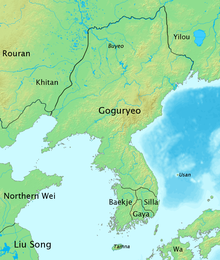Three Kingdoms (Korea)
| Three Kingdoms of Korea | |

Map of the Three Kingdoms of Korea, at the end of the 5th century.
|
| Three Kingdoms of Korea | |
| Other name | |
|---|---|
| Chosŏn'gŭl | 세나라시기 |
| Revised Romanization | Senara-sigi |
| McCune–Reischauer | Senara-sigi |
The concept of the Three Kingdoms of Korea (Hangul: 삼국시대) refers to the three kingdoms of Baekje (백제), Silla (신라) and Goguryeo (고구려). Goguryeo was later known as Goryeo (고려), from which the modern name Korea is derived. The Three Kingdoms period was defined as being from 57 BC to 668 AD (but there existed about 78 tribal states in the southern region of Korean peninsula and relatively big states like Okjeo, Buyeo, and Dongye in its northern part and Manchuria).
The three kingdoms occupied the entire Korean Peninsula and most of Manchuria, located in present-day China and Russia. The kingdoms of Baekje and Silla dominated the southern half of the Korean Peninsula and Tamna, whereas Goguryeo controlled the Liaodong Peninsula, Manchuria and the northern half of the Korean Peninsula. Baekje and Goguryeo shared founding myths and originated from Buyeo.
In the 7th century, allied with China under the Tang dynasty, Silla unified the Korean Peninsula for the first time in Korean history, forming a united Korean national identity for the first time. After the fall of Baekje and Goguryeo, the Tang dynasty established a short-lived military government to administer parts of the Korean peninsula. However, as a result of the Silla–Tang Wars (≈670–676), Silla forces expelled the Protectorate armies from the peninsula in 676. The following period is known as the Unified Silla or Later Silla (668–935).
...
Wikipedia
